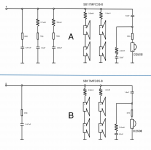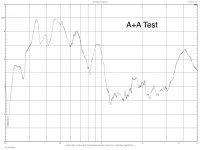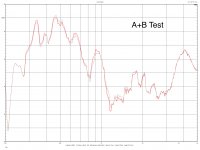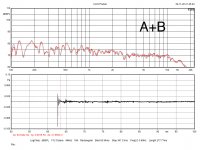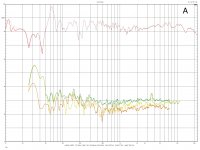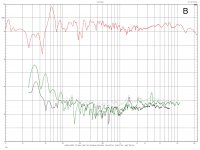Yes. I am able to get some differences in the measurements. Are they audible? Despite what I wrote about earlier, I am not sure now. I will keep checking it. The very fact that I change something can have an impact on my judgment. My opinion is not enough.
Crossover. A and B
A + A Test. Enlarged. These are two measurements with the same settings. You can see the same waveform. Overlaps.
A + B Test. Enlarged. There is a difference.
A + B 100-20K. A wider range of.
Edit. Oh. Measurement in a living room. 25m.
Crossover. A and B
A + A Test. Enlarged. These are two measurements with the same settings. You can see the same waveform. Overlaps.
A + B Test. Enlarged. There is a difference.
A + B 100-20K. A wider range of.
Edit. Oh. Measurement in a living room. 25m.
Attachments
Last edited:
Yes. I am able to get some differences in the measurements. Are they audible?
Hard to say. The differences are small and there is a bit if noise in the data. That said, half a dB difference over a wide frequency range can be very audible.
You could measure the electrical transfer function at the xover input. This should have much less noise and wiggles, and might be more conclusive.
Distortion measurements would be interesting, too.
I am not sure what you are referring to.You are aware of the flat impedance/back emf/current distortion argument I presume?
I read the the "Why do amplifiers sound different?" the text by Hans van Maanen. Its an interesting and mostly clear text, but I don't agree 100% where he argues that class AB amps have issues controlling the current when the output voltage is zero, whereas class A amps don't have that problem. I am wondering if you see any other points I may have missed.
Joe's idea that load induced current phase shift at the output terminals, what he's called current distortion from time to time, somehow upsets amplifiers. I don't think you are missing anything. He has shown the "current distortion" measured at the amp terminals and suggested that is what we listen to, this, of course, has been argued against on many occasions but it's still not clear whether or not he has understood his error in this assumption.
Last edited:
You could measure the electrical transfer function at the xover input.
I do not understand this. How to do it?
I am not familiar with your test equipment, but basically you replace the microphone (and microphone pre-amp, if any) with a direct wire connection between the loudspeaker terminals and the input to audio audio interface. Instead of an acoustic measurement, you take an electronic measurement.
Last edited by a moderator:
Joe's idea that load induced current phase shift at the output terminals, what he's called current distortion from time to time, somehow upsets amplifiers. I don't think you are missing anything. He has shown the "current distortion" measured at the amp terminals and suggested that is what we listen to, this, of course, has been argued against on many occasions but it's still not clear whether or not he has understood his error in this assumption.
Hold on... the current phase shift at the amplifier terminals!? Of course this will change if impedance compensation networks are added. But that is irrelevant, because the amplifier current is the sum of the currents passing through the xover/driver(s) and the compensation networks. However, the sound produced by the driver results from the current running through the voice coil(s) only, which is not changed in any way by adding impedance compensation networks.
I'm pretty certain I've represented what he's been saying accurately, apologies if I haven't, it's often not easy to follow his posts.
...that holds as long as we can neglect the amplifier's output impedance (or resistance) into the equation.However, the sound produced by the driver results from the current running through the voice coil(s) only, which is not changed in any way by adding impedance compensation networks.
IF the amplifier's output resistance is somewhat a fraction of the load impedance, such RLC networks would mofify the amplifier's output voltage significantly and this will absolutely be audible.
Kal.
Yes, see post 3285. However, the question is if/how adding the compensation networks can change the sound even if the amp has low output impedance (take a look at JarBars recent posts to get the full picture).
Four guests. I have not revealed what the subject of the test is. Their only task was to describe the impressions after listening to three songs. Each with two settings (with and without compensation networks).
Two of them described the changes exactly as I perceived them when I listened to them the first time. Without compensation networks. That the sound is clearer.
One undecided person. One preferred the sound with the original crossover. Claiming that stereo is better. Imaging of instruments and vocals.
Two of them described the changes exactly as I perceived them when I listened to them the first time. Without compensation networks. That the sound is clearer.
One undecided person. One preferred the sound with the original crossover. Claiming that stereo is better. Imaging of instruments and vocals.
Hi mbrennwa,
Agreed.
With such an amp, there should be no influence adding these networks or removing them, unless...the amp feedback is not 100% on voltage but a mix (voltage+current) feedback. @JarBar: Do we know smthing about it?
Agreed.
With such an amp, there should be no influence adding these networks or removing them, unless...the amp feedback is not 100% on voltage but a mix (voltage+current) feedback. @JarBar: Do we know smthing about it?
But maybe there's something else that I have missied. Can you provide some pointers?
The basic argument is that the voltage and current are out of phase with a reactive load and that an amplifier is incapable of driving the base of an output device properly if this is so. Simply writing out the closed loop response using complex variables would show that this is not so. Instead we have the "back emf impedance" and all the other nonsense.
BTW we were there years ago on shunt networks and ideal voltage sources, nothing sank in at all.
No, you can shout "supprime tuum stultiloquium" in any live or dead language, but something like Teflon 2.0 might be covering the thinking parts.
Define 'electrical signal' and why we are not listening to it. You mean the cone is excited all by itself. Have you heard of Kirchoff's Law?
Don't bother answering, you have been a troll all along. Sorry I even have to say that, but in a "No Facts World" I am becoming used to it.
Like I predicted, there will be opposition, even if the physics is correct.
Expect no further comment. I will let you have the last word and just ignore it, your reputation precedes you.
-
I'm going to weigh in on this whole debate from the perspective of a really smart person, who doesn't understand almost any of this debate (when it come to speaker design).
I'm not a speaker designer, I'm someone who can follow directions.
I'm reminded of Henry Ford in this whole discussion. The Chicago Tribune wrote an article calling Henry Ford "ignorant" because he had something like a 6th grade education. (Henry Ford of the oldest car in the world.) Ford sued the newspaper...and they took it to court, and Ford won.
Ford was not an engineer, just someone who knew what he was doing...and he proved it. I've made a lot of money off of Ford dealerships 100 + years later.
So as someone whose built Joe's Elsinore's, my brothers has Mark Levinson amps driving Dun Lavy speakers...I would just say, I'm going to go by what I'm hearing. Not to mention this is page what 20,000 of this thread for this speaker, in spite of self-absorbed know it all "sound engineers"
Now again, this is just coming from someone who owns his own business, knows how to read instructions...oh, and read people!
Here's how I read people on this thread on this subject when it comes to Joe's insight when you disagree with him.
Complete and total TEMPER Tantrum! Yes I see you as children.
You so desperately want to prove Joe wrong, to someone like me, it just sounds pathetic!
Oh, I've built the Elsinore's...so not one damn thing you say will EVER discredit Joe.
But it seems to me that the whole point that many of you are pissed, no jealous about...
Joe did something none of you could do, and worse, he published his build for free!
Oh, and did I mention it's incredible! The Elsinore's are incredible!
Oldest car in the world?
Whatever the merits on either side, the argument is not about the Elsinores, and should probably have its own thread.
Mods: some help here?
Whatever the merits on either side, the argument is not about the Elsinores, and should probably have its own thread.
Mods: some help here?
Last edited:
...the argument is not about the Elsinores, and should probably have its own thread.
Yes!
The Elsinores are a fine design.
The argument is about the Joes new (?) findings, which he keeps mentioning in this thread. What exactly did he find? Are his conclusions right? Why does he not disclose his news?
Joe, you could start a new thread about your current-drive thoughts in order to keep this thread for the Elsinore builders.
- Home
- Loudspeakers
- Multi-Way
- The "Elsinore Project" Thread
